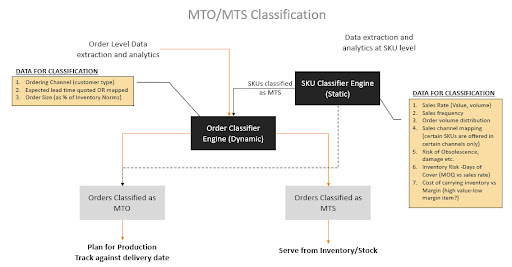
Mto Vs Mts: The Difference
Make-to-Order (MTO) produces items after orders are received, minimizing inventory but increasing lead times. Make-to-Stock (MTS) manufactures based on demand forecasts, ensuring availability but at higher inventory costs. The choice depends on supply lead time, customer expectations, and business goals.
One of the key metrics that almost all organizations work towards achieving is On-Time Performance, a measure of the reliability of a process or an organization. To achieve high on-time performance, and enhance customer satisfaction, the first and probably the most important step is to leverage customer analytics services, enabling you to give your customers the right delivery time-lines or delivery lead time. The right delivery lead time for a product is defined either by the customers (in cases where there are competitors/substitutes easily available) OR by the company based on internal constraints.
High-tech makers of industrial machinery typically use ‘Made-To-Order’ processes wherein the machines are either manufactured or assembled against a firm order and the customer who gives the order is willing to wait for his delivery. At the other extreme, commodity goods suppliers (like cement, salt manufacturers) generally are “Make-to-Stock” & maintain inventories at multiple echelons in their network, to ensure they are ready to serve demand from their consumers.
Unfortunately, most industrials and manufacturing based organizations tend to be a mix of MTO and MTS products. They constantly grapple with the problem of deciding which items to service from stock and which products to offer but produce only against orders. Should all fast movers be MTS and slow movers be MTO? Is MTS or MTO dependant on my competitors/substitutes? If an item once defined as MTS remain MTS forever?
In the following section, we discuss the conceptual definition of MTO and MTS.
Defining Make-To-Stock (MTS) and Made-To-Order (MTO)
In its simplest form, there are two key factors that define whether an item or an order is MTS or MTO – Supply Lead Time (SLT) or the time it takes to produce/supply the item to a customer AND Customer expected Lead Time (CLT) or the time that a customer/consumer expects the item to be made available. An important point to note here is that both SLT and CLT are not specific to an ITEM but to an ORDER.
Simply put –
Any order where the supply lead time (SLT) is less than the customer expectation lead time (CLT), the order can be referred to as “MTO”, otherwise the order is MTS
- If SLT <= CLT then MTO
- If SLT > CLT then MTS
Thus, the first level of MTO/MTS definition is at an Order level.
Issues with this Definition.
An important part of the above discussion is an organizations ability to judge the CLT. Though CLT is fundamentally impacted by the way a product is consumed (e.g. grocery items are typically required immediately and consumed daily), it is also impacted by a) Availability b) Technology c) Pricing d) Competition/Substitutes e) Others. What this also means (and as stated earlier) is that for the same item, while some set of consumers are willing to wait (CLT is high => MTO), another set of consumers may want them immediately (MTS). E.g. a specific brand of tea powder may be MTS in a certain geographic area, but may be treated as an MTO for orders coming in from other geographies
Some quick ways to assess whether a product is an MTS or MTO include –
- Are there competitors or like-for-like substitutes available for the product?
- Does availability significantly impact the sales of the item?
- What is the profile of the end consumer/customers? For e.g. the same product could be supplied to retail chain (MTS) and a commercial project (MTO).
- Is our end consumer willing to quote a delivery date OR will they find an alternate source/product?
Though the MTO/MTS definition of an order or an SKU is typically customer backwards, companies tend to follow simplified “thumb-rules”. For example, one of the companies that we worked for, that was into manufacturing bathroom accessories, had a simple rule that all items that are Fast moving will be MTS and the rest of the SKUs will be treated as MTO.
This view of the industry (quite prevalent) does work to a large extent. It is a good enough approach that helps companies get it right on most occasions. But a few problems that this simple approach poses are –
- A lot of manufacturing companies today serve a range of customers (retail, projects, distributors etc.); as discussed earlier, SKU can be MTS for a retail customer and MTO for a “projects” customer. In a manufacturing organization, with constrained capacity, to serve an MTO customer from stock (like MTS) is a crime as it is a wastage of limited capacity/resource.
|
Retail Customers |
Distributors |
Project Customers |
|
|
Fast Moving SKUs |
MTS |
MTS |
MTO/MTS |
|
Slow Moving SKUs |
MTS/MTO |
MTO |
MTO |
- Abnormally large orders are served from inventory many times, depending on the customer type and ordering mechanism (as the item that has been classified as MTS). This leads to the item being unavailable for a large section of smaller customers, leading to urgency orders in manufacturing.
- The MTS/MTO definitions, typically end up being static; items classified as MTO typically get de-prioritized (as there is no inventory) and the range is not upsold actively. This behavior over a period of time leads to a shrinking of the product range.
Suggested Solution to MTO/MTS classification:
With sufficient data available today across most organizations, we have built data-driven tools to classify SKUs and more importantly ORDERS into MTO and MTS
Tredence MTO-MTS solution:
Some of the key data points that we look at for MTO/MTS decision making are:
- Expected Lead time by customer (CLT v SLT, Master data)
- Sales Rate (Value, volume)
- Sales frequency
- Order volume distribution
- Sales channel mapping (certain SKUs are offered in certain channels only)
- Risk of Obsolescence (fashion?), damage etc.
- Inventory Risk -Days of Cover (MOQ vs sales rate)
- Cost of carrying inventory vs Margin (high value-low margin item?)
- Order size (Elephant orders)
This data driven model that can assist in making the MTO/MTS decision dynamically and provide a planner with answers to –
- Inventory planner – “Do I keep SKU A in stock or Not?”
- Fulfillment planner – “Do I treat this new order in the system as an MTO or an MTS from units available in the inventory?”
- Production planner –
- “How much production line capacity should I allot to MTS and MTO (for MTO date planning)?
- How do I prioritize between MTO and MTS orders?”
How does it Add Value to the Client?
- Reduced inventory cost, inventory optimization, capital cost (w.r.t damages, inventory obsolescence, etc.), cost of inventory, cost of damages/obsolescence. It also frees up WH space, optimizes working capital and thus, reduces the overall cost to company.
- Better capacity utilization and reduced production losses – with lesser instances of procurement expediting expenses.
- Improves Sales through improved stock/product availability.
- Improved On-Time Delivery performance (right use of capacity and right expectation setting).
All in all, the Customer Lead Time analysis and management can influence the MTO-MTS productivity. With right approach and assistance, not only can the CLT be met but working capital and inventory costs can be reduced.
Topic Tags






